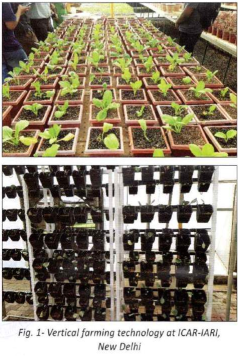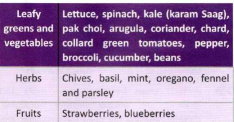ForumIAS announcing GS Foundation Program for UPSC CSE 2025-26 from 19 April. Click Here for more information.
Adoption of Advanced farming methods like Vertical Farming and Hydroponics is necessary for sustainable and efficient food production systems to meet the demands of growing population. In India, hydroponics and vertical farming are gaining importance considering the increasing demand for leafy, green vegetables and fruits like strawberries and blueberries.

What is Vertical Farming and Hydroponics?
Vertical Farming- It is an indoor urban technique involving large-scale food production within multi-storey buildings. It adopts a unique approach to maximise space and efficiency by cultivating plants in vertically stacked layers or inclined surfaces, often
within controlled environments like greenhouses or warehouses. It frequently utilises controlled-environment agriculture (CEA) techniques to optimize factors such as light, temperature, humidity, and nutrients.
Nutrient Providing Method- Various shapes and sizes of vertical farms worldwide employ one of three nutrient-providing methods- Hydroponics, Aeroponics and Aquaponics.
| Hydroponics | This prevalent technique involves growing plants on soil-free substances continuously irrigated with nutrients. Plant roots are submerged in a nutrient solution, and the system uses 60-70% less water than traditional agriculture, making it widely utilised in numerous vertical farms worldwide. |
| Aeroponics | Aeroponics cultivates plants in a soil-free mist environment with roots hanging down in a closed-air container. This method uses 90% less water than hydroponics, making it a highly efficient system of food production. Plants grown aeroponically absorb more nutrients, resulting in healthier and more nutritious produce. |
| Aquaponics | Aquaponics integrates fish production into plant cultivation. The system utilises fish-produced nutrient rich waste as a feed resource for plants, and plants, in turn, purify and recycle wastewater for fish ponds. |
Crops suitablility

What is the need for Vertical Farming and Hydroponics in India?
1. Diminishing Farmlands and increasing urbanisation- According to UN report, 53% of Indian Population is expected to live in cities by 2050. Vertical and hydroponic farming, can ease pressure on agricultural lands for a healthier and more sustainable future.
2. Potential for Economic Growth- According to IMARC Group’s latest research report, the India vertical farming market is expected to demonstrate a CAGR of 25.4% during the period 2023-2028, which will propel economic growth.
3. Address the diminishing production due to climate change- It is a contemporary practice of cultivating crops in stacked layers within protected indoor environments, can help in addressing diminishing agricultural resources due to changing climate.
4. Enhancing food production- It has the potential to enhance food production, maintain quality and contribute to sustainable urban farming.
| Read More- Methods of Farming |
What are the associated advantages?
1. Less land requirement- Hydroponics in conjunction with vertical farming utilises 99% less land compared to traditional farming due to the concentrated root system.
2. Year-round cultivation of seasonal crops- It enables the creation of a controlled microclimate, allowing year-round indoor cultivation of regional or seasonal crops.
3. Reduced need of pesticides- It protects crops from soil-borne pests and diseases, and adverse weather conditions, thereby reducing the need for pesticides and fertilisers.
4. Flexibility of installation- It is flexible to set up locations of vertical farming anywhere. Hence, it reduces transportation and warehouse costs, streamlining the supply chain.
What are the associated Challenges?
1. Shortage of Skilled labour Force- There is shortage of expert labour force which can execute vertical farming, leading to elevated labour costs.
2. Increased cost of production- Vertical Farming is highly energy-intensive having artificial lighting, temperature, and humidity requirements, which increases the cost of production.
3. Absence of natural pollinators- There is absence of natural pollinators in controlled conditions. This can result in poor fruit sets and the production of small, misshapen fruits.
4. Confined range of crop production- The range of crops cultivated commercially is usually confined to leafy vegetables and microgreens.
5. Regular maintenance requirement- It requires continuous attention and care, with components like pumps and nutrient delivery systems needing regular maintenance.
What should be the way Forward?
1. Increasing affordability- Vertical farming’s affordability can be enhanced by utilising cheap and available shipping containers and abandoned warehouses.
2. Collaborative research- Collaborative research must be undertaken in the field of vertical farming to enhance technological practices for increased sustainability.
3. Supportive policies- Supportive policies and incentives, like grants and tax benefits, can encourage investment and promote urban agriculture through agri-startups.
| Read More- Indian Express UPSC Syllabus- GS 3- Modern agricultural techniques |




